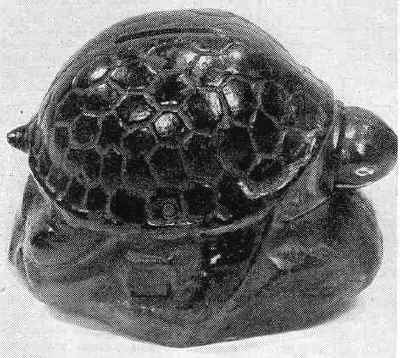Turtle Bank
by F.H. Griffith - HOBBIES Magazine - November, 1955

A mechanical bank with an exceptionally recent manufacturing period is the rather exceptional choice to occupy No. 41 in our numerical classification of mechanical banks. The bank is the Turtle Bank and it was made in apparently limited quantities sometime during the period of 1926-1934.
The bank was designed and modeled by M. Elizabeth Cook, an artist and sculptress, and it was manufactured by the Kilgore Manufacturing Company of Westerville, Ohio. The Kilgore Com-pany's main line was the manufacture of toy cap pistols. However, during 1926 they introduced a series of four mechanical banks, an Owl, a Frog, a Rabbit, and a Turtle, all designed by M. Eliza-beth Cook. The first three were apparently made in large quantities and had wide distribution. But the Turtle, for some reason, obviously had limited production and distribution as while the first three are rather common, the Turtle is quite rare.
The four banks each had their own individual name and were called as a group 'The
Thrifty Four.' The names of the individual banks were descriptive of the action in each
case. Jug-O-Rum, the Frog, opens his mouth as though croaking his name. Blinky, the Owl,
blinks his eyes. Flop-Ears, the Rabbit, flops his ears up and down, and Pokey, the Turtle,
pokes his head out. Each bank was packed in a cardboard box and on each box was a poem
that linked the banks together as a series. As example, the following poem is from the box
containing Flop-Ears, the Rabbit:
"Flop-Ears, the Rabbit, hops around,
Lifting his ears for every sound,
He sees Blinkey, the Owl, high in an Oak,
And hears the Frog, Jug-O-Rum croak,
And wonders if Pokey, the Turtle, so slow,
Can catch up with him, if he hops real slow.
Flop-Ears, the thoughtful Rabbit
Says, 'Get The Saving Habit' ".
The bank shown is from the fine collection of Mr. Morton Bodfish and the writer expresses
ap-preciation to both Mr. Bodfish and Mr. Ralph J. Lueders for the picture of the Turtle
bank. The bank was obtained by Mr. Bodfish through the purchase of the Lederer collection.
It is believed to have originally been part of the late James C. Jones' collection. It is
in fine mint condition with original paint and no repairs. The bank is painted as follows:
The rock-like base is green and the under edge of the shell is orange, the shell itself is
black, and the head, neck, and legs are also black. The outline of the mouth is yellow and
the eyes are white. The body section on each side of the head is blue and the underside of
the head is yellow.
The operation of the bank is quite simple but desirable since a coin is necessary to cause the ac-tion. As can be seen in the picture the coin slot is in the top of the shell. When a coin is pressed into this slot the neck and head of the turtle protrude about a half inch. As the coin drops into the bank the head and neck return to their original position as shown. There is a key-locking coin trap in the base of the bank for removal of coins. The size of the bank is of interest since it is quite small being only 3½ inches long and 3 inches high.
The number of Turtle Banks that have been found so far is very limited and the number known to be in private collections is less than the fingers on one hand. Actually it's a very desirable little mechanical bank although it means more to the advanced collector than the beginner. This, of course, due to the fact that it's not particularly imposing as to appearance or spectacular as to action. It's a hard bank to find and none have turned up in recent years. This in spite of the fact that it has such a late date of manufacture.
